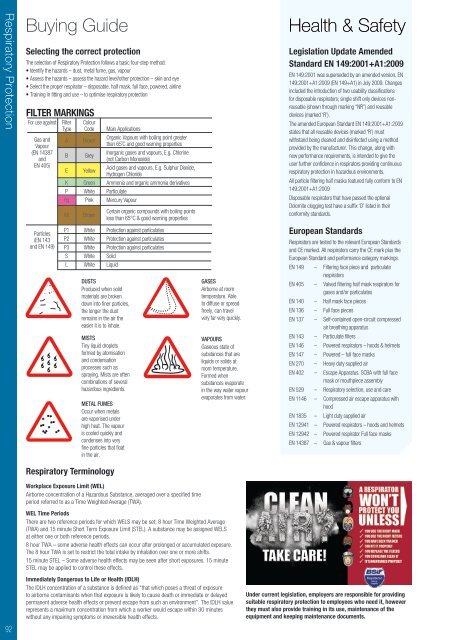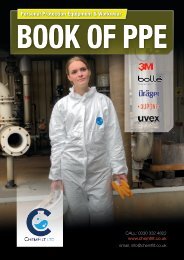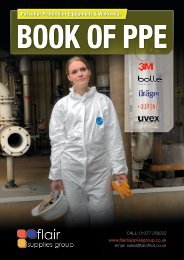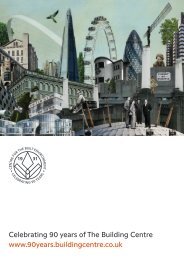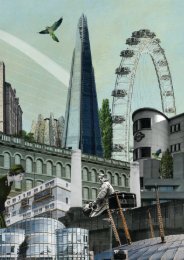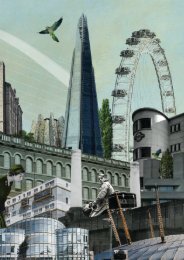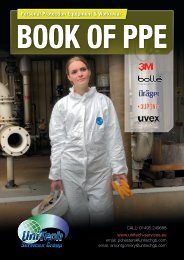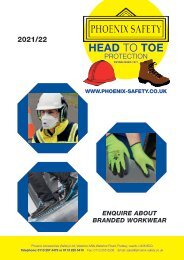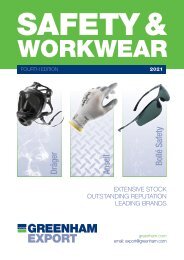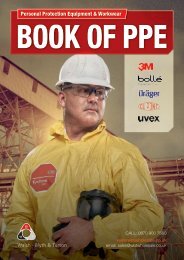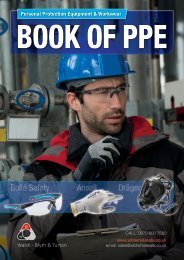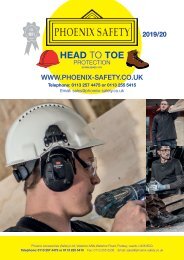Phoenix Safety Head to Toe Protection Catalogue 2021
Phoenix Safety Head to Toe Protection Catalogue 2021
Phoenix Safety Head to Toe Protection Catalogue 2021
You also want an ePaper? Increase the reach of your titles
YUMPU automatically turns print PDFs into web optimized ePapers that Google loves.
Respira<strong>to</strong>ry <strong>Protection</strong><br />
Buying Guide<br />
Selecting the correct protection<br />
The selection of Respira<strong>to</strong>ry <strong>Protection</strong> follows a basic four-step method:<br />
• Identify the hazards – dust, metal fume, gas, vapour<br />
• Assess the hazards – assess the hazard level/other protection – skin and eye<br />
• Select the proper respira<strong>to</strong>r – disposable, half mask, full face, powered, airline<br />
• Training in fitting and use – <strong>to</strong> optimise respira<strong>to</strong>ry protection<br />
FILTER MARKINGS<br />
For use against<br />
Gas and<br />
Vapour<br />
(EN 14387<br />
and<br />
EN 405)<br />
Filter Colour<br />
Type Code Main Applications<br />
A Brown<br />
Organic Vapours with boiling point greater<br />
than 65˚C and good warning properties<br />
B Grey<br />
Inorganic gases and vapours, E.g. Chlorine<br />
(not Carbon Monoxide)<br />
E Yellow<br />
Acid gases and vapours, E.g. Sulphur Dioxide,<br />
Hydrogen Chloride<br />
K Green Ammonia and organic ammonia derivatives<br />
P White Particulate<br />
Hg Pink Mercury Vapour<br />
AX<br />
Brown<br />
Certain organic compounds with boiling points<br />
less than 65°C & good warning properties<br />
Health & <strong>Safety</strong><br />
Legislation Update Amended<br />
Standard EN 149:2001+A1:2009<br />
EN 149:2001 was superseded by an amended version, EN<br />
149:2001+A1:2009 (EN 149+A1) in July 2009. Changes<br />
included the introduction of two usability classifications<br />
for disposable respira<strong>to</strong>rs; single shift only devices nonreusable<br />
(shown through marking “NR”) and reusable<br />
devices (marked ‘R’).<br />
The amended European Standard EN 149:2001+A1:2009<br />
states that all reusable devices (marked ‘R’) must<br />
withstand being cleaned and disinfected using a method<br />
provided by the manufacturer. This change, along with<br />
new performance requirements, is intended <strong>to</strong> give the<br />
user further confidence in respira<strong>to</strong>rs providing continuous<br />
respira<strong>to</strong>ry protection in hazardous environments.<br />
All particle filtering half masks featured fully conform <strong>to</strong> EN<br />
149:2001+A1:2009<br />
Disposable respira<strong>to</strong>rs that have passed the optional<br />
Dolomite clogging test have a suffix ‘D’ listed in their<br />
conformity standards.<br />
Particles<br />
(EN 143<br />
and EN 149)<br />
P1 White <strong>Protection</strong> against particulates<br />
P2 White <strong>Protection</strong> against particulates<br />
P3 White <strong>Protection</strong> against particulates<br />
S White Solid<br />
L White Liquid<br />
DUSTS<br />
Produced when solid<br />
materials are broken<br />
down in<strong>to</strong> finer particles,<br />
the longer the dust<br />
remains in the air the<br />
easier it is <strong>to</strong> inhale.<br />
MISTS<br />
Tiny liquid droplets<br />
formed by a<strong>to</strong>misation<br />
and condensation<br />
processes such as<br />
spraying. Mists are often<br />
combinations of several<br />
hazardous ingredients.<br />
METAL FUMES<br />
Occur when metals<br />
are vaporised under<br />
high heat. The vapour<br />
is cooled quickly and<br />
condenses in<strong>to</strong> very<br />
fine particles that float<br />
in the air.<br />
GASES<br />
Airborne at room<br />
temperature. Able<br />
<strong>to</strong> diffuse or spread<br />
freely, can travel<br />
very far very quickly.<br />
VAPOURS<br />
Gaseous state of<br />
substances that are<br />
liquids or solids at<br />
room temperature.<br />
Formed when<br />
substances evaporate<br />
in the way water vapour<br />
evaporates from water.<br />
European Standards<br />
Respira<strong>to</strong>rs are tested <strong>to</strong> the relevant European Standards<br />
and CE marked. All respira<strong>to</strong>rs carry the CE mark plus the<br />
European Standard and performance category markings.<br />
EN 149 – Filtering face piece and particulate<br />
respira<strong>to</strong>rs<br />
EN 405 – Valved filtering half mask respira<strong>to</strong>rs for<br />
gases and/or particulates<br />
EN 140 – Half mask face pieces<br />
EN 136 – Full face pieces<br />
EN 137<br />
– Self-contained open-circuit compressed<br />
air breathing apparatus<br />
EN 143 – Particulate filters<br />
EN 146<br />
EN 147<br />
EN 270<br />
EN 402<br />
EN 529<br />
– Powered respira<strong>to</strong>rs – hoods & helmets<br />
– Powered – full face masks<br />
– Heavy duty supplied air<br />
– Escape Apparatus. SCBA with full face<br />
mask or mouthpiece assembly<br />
– Respira<strong>to</strong>ry selection, use and care<br />
EN 1146 – Compressed air escape apparatus with<br />
hood<br />
EN 1835<br />
– Light duty supplied air<br />
EN 12941 – Powered respira<strong>to</strong>rs – hoods and helmets<br />
EN 12942 – Powered respira<strong>to</strong>r Full face masks<br />
EN 14387 –<br />
Gas & vapour filters<br />
Respira<strong>to</strong>ry Terminology<br />
92<br />
Workplace Exposure Limit (WEL)<br />
Airborne concentration of a Hazardous Substance, averaged over a specified time<br />
period referred <strong>to</strong> as a Time Weighted Average (TWA).<br />
WEL Time Periods<br />
There are two reference periods for which WELS may be set; 8 hour Time Weighted Average<br />
(TWA) and 15 minute Short Term Exposure Limit (STEL). A substance may be assigned WELS<br />
at either one or both reference periods.<br />
8 hour TWA – some adverse health effects can occur after prolonged or accumulated exposure.<br />
The 8 hour TWA is set <strong>to</strong> restrict the <strong>to</strong>tal intake by inhalation over one or more shifts.<br />
15 minute STEL – Some adverse health effects may be seen after short exposures. 15 minute<br />
STEL may be applied <strong>to</strong> control these effects.<br />
Immediately Dangerous <strong>to</strong> Life or Health (IDLH)<br />
The IDLH concentration of a substance is defined as “that which poses a threat of exposure<br />
<strong>to</strong> airborne contaminants when that exposure is likely <strong>to</strong> cause death or immediate or delayed<br />
permanent adverse health effects or prevent escape from such an environment”. The IDLH value<br />
represents a maximum concentration from which a worker would escape within 30 minutes<br />
without any impairing symp<strong>to</strong>ms or irreversible health effects.<br />
Under current legislation, employers are responsible for providing<br />
suitable respira<strong>to</strong>ry protection <strong>to</strong> employees who need it, however<br />
they must also provide training in its use, maintenance of the<br />
equipment and keeping maintenance documents.


